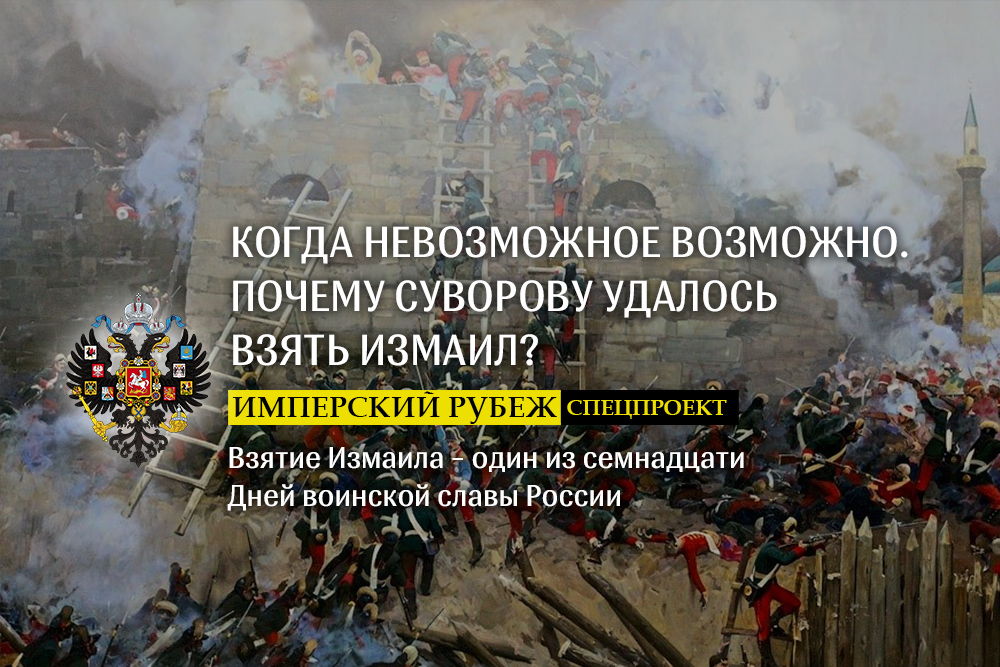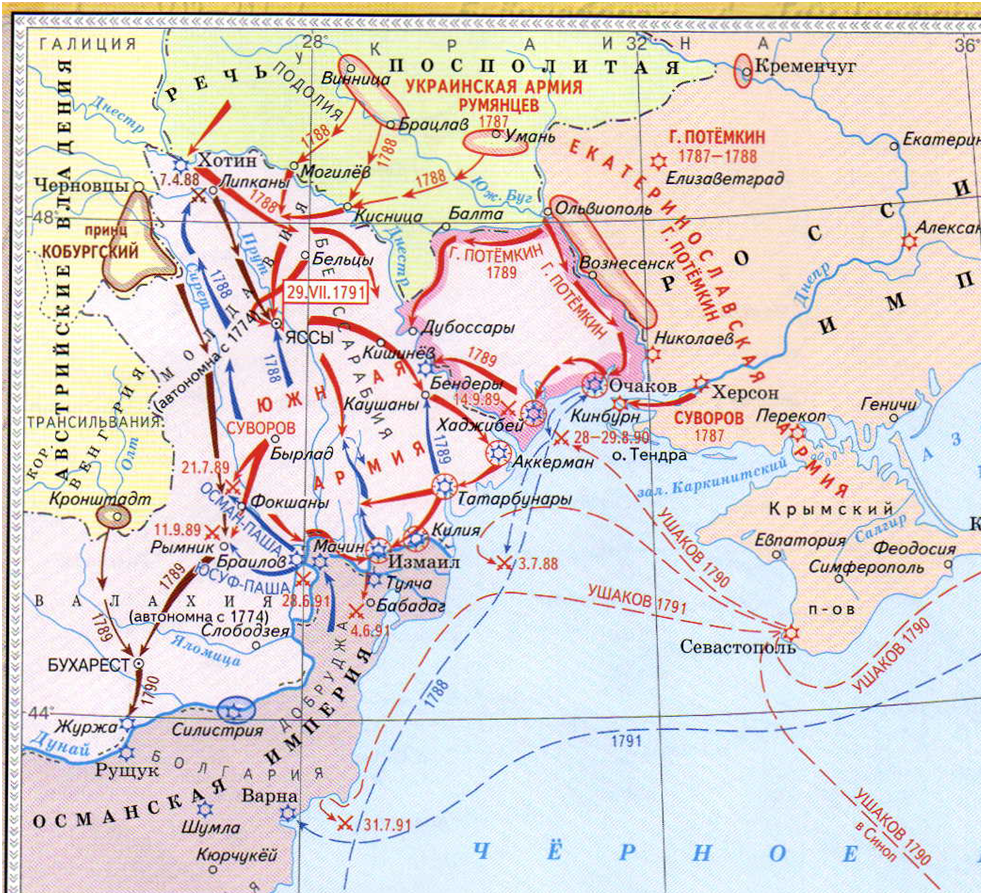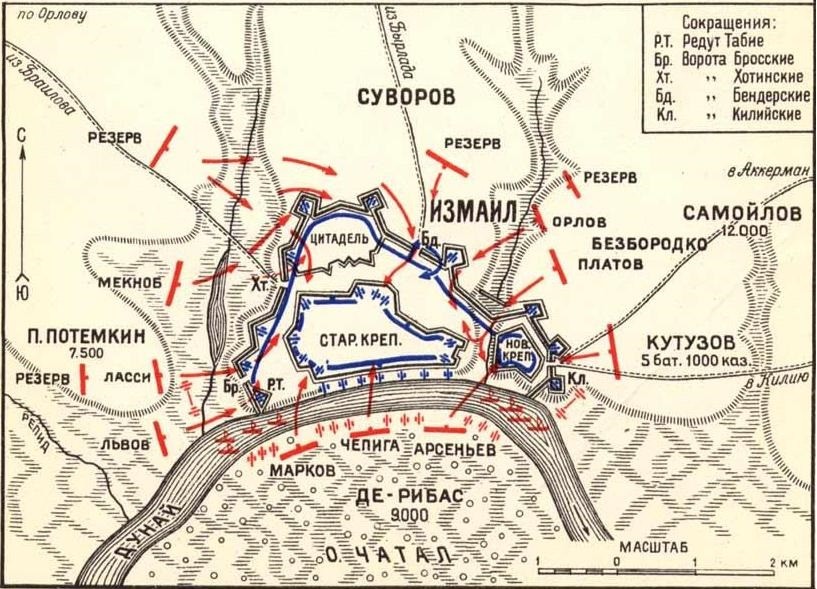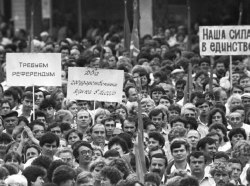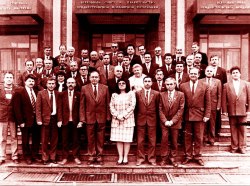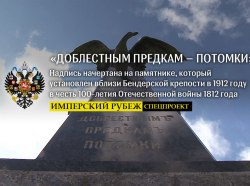In the information space, public discussions and even in the kitchen conversations, Pridnestrovie is often referred to as the Russian outpost on the Dniester. Such a metaphor is not far from the truth, given the events of recent decades in the region. However, Pridnestrovie territory became the outpost of the Russian world long before the formation of the modern political coordinate system. It happened more than two hundred years ago in the last decade of the XVIII century. After another war with Turkey (1787-1791), Dniester became the south-western border of Russia, and the Middle (Tiraspol) fortress emerged on its left bank, which became a symbol of Russian civilization assertion in the region.
This was preceded by a fascinating chain of events forged by the incredible stamina of Russian soldiers and the brilliant military skills of Alexander Suvorov. One of the links in this chain is the epic assault of Izmail, the date of which is noted in the list of 17 Days of Russian military glory.
What does this date mean?
In this list, there is a solemn date of the fortress capture, the fall of which, according to the Turkish metaphor, should have caused “the overthrow of the heavens to the earth and Danube river`s flow reversal” falls on 24th of December. Meanwhile, actually, the day of the storming was announced on December 22, and in all documents relating to the course of the Russian-Turkish war of 1787-1791, the date of the storming of the fortress is marked on December 11. Here we are confronted with the difference between the Julian (old style) and the Gregorian (new style) calendars. This difference gradually increases due to the different number of leap years, and today is estimated at 13 days. But since it is a question of the XVIII century, by this date it is necessary to add 11 days of the difference between two calendars. However, the list of the Days of Russia Military Glory was compiled in the XX century, and when calculating the dates according to the old style, out of habit, not eleven, but thirteen days were added.
“It happened that the memorable date was set for December 24, and in the description they noted that, in fact, the day of the assault was the day of December 22, 1790 in a new timing and December 11 in an old one” - the Russian Planet publication journalist Sergey Antonov writes in his article.
But let`s return to the chain of events and try to find out what happened in this day under the walls of the Turkish fortress and why is it also an important historical date for Pridnestrovie?
What had happened?
The starting point of the plexus of causes and effects that led to the Izmail epic and its results was, oddly enough, the “Crimean Question”. By the way, the Crimea in Russian history had repeatedly played a crucial part, being a kind of indicator of Russia's power level - its accession in 1783 marked the beginning of the era of dominance of the Russian Empire in the Black Sea basin, and it was the defeat in the Crimean War of 1853-1856 that showed Russia`s gap with the Western world.
Crimea also became a challenge for Russia in 1787, when Turkey, hoping to take revenge on past concessions to St. Petersburg, demanded the peninsula back. By this time, the Ottomans were able to recover from the former unsuccessful war with the Russians of 1768-1774 and inspired by the Western powers (Russia always had “friends”) threatened with Islam green banner again. Russia rejected Istanbul claims and received a declaration of war in response.
Being involved in a conflict with Petersburg, Turkey relied on Russia's foreign policy problems rather than on its own military forces. The Sultan`s advisers made conclusions from the previous wars with the Russians and were well aware that it would be difficult to defeat them in open battles - militarily, Russia was still better prepared. Therefore, Istanbul bet on a long-term positional war - the Ottomans hoped that the Russians would get bogged down in sieges of numerous fortresses, which would lead to dispersal and weakening of their forces. To that end, the Turks have well strengthened their strongholds in the Northern Black Sea region, hoping that the advancing enemy will stumble over them. In this case, the Turkish strategists thought, it would be possible to “catch” the weakened Russian armies in parts, which would add chances of victory. The calculation was also that the protracted war would inspire Russia`s traditional rivals, such as Sweden or Prussia, and they, taking advantage of the situation, would attack it. This plan of the Turks could have worked, while the Russian army, led by the favorite of Catherine II, Grigory Potemkin, sat for half a year under the Turkish Ochakov, Sweden declared war on Russia. But Russian army and navy made their adjustments in this alignment, as has happened more than once in history.
While the main forces of the Russians slowly but surely took the fortress behind the fortress, the small corps of General Alexander Suvorov struck a crushing defeat against the numerically superior Ottomans in the famous battle of 1789 (now the territory of Romania). After this defeat, active actions against Russians were out of question. While the new army was being formed, the Turks hoped to detain the Russian troops on the Danube. And here a special role was attached to the powerful and modern fortress of Izmail.
After the first years of the war defeats, the Lower Danube was the last Ottoman frontier in the Northern Black Sea region - to keep it was a number one issue. Its loss would mean a Russian breakthrough in the Balkans, which could provoke an uprising of the Slavic peoples against the Turks and then not only the war, but the whole Ottoman Empire would have come to an end.
Earlier, a network of fortresses was created there - a real defense complex, as historian Andrei Krasnozhon from Odessa put it. Tulcea, Braila, Galati and Kiliya defended Danube delta, but Izmail was the cornerstone of this defense line. In the last war, the Russians dealt with it rather quickly, but this time they were in for an unpleasant surprise.
Fortress without breaking point
Approaching Izmail in the middle of November 1790, the Russian army saw the newest fortress for its time. Contrary to popular belief, it had no stone walls. The high walls of the museum diorama are nothing more than an artist’s fiction.
In the era of advanced artillery, they lost all meaning, as they were easily destroyed by siege weapons. Therefore, Izmail was surrounded by powerful earthen ramparts - the cannonball, when hit in the parapet, was stuck in the embankment of the structure. Such a fortress was built by European engineers in the 70s-80s of the 18th century, and historians like to savor the characteristics of Izmail, because they were really impressive. The ramparts, the total length of which was 7 kilometers, were defended by 380 guns and 35 thousand people, 10 thousand of whom were elite units. The assailants had to climb the first line of fortifications, then overcome a wide moat eight meters deep. Then it was necessary to climb the 20-meter slope on the main shaft, where the Turks were waiting with bayonets.
The fortress, adjacent to the Danube, was vulnerable from the river side, but the whole bank was swept so that to get close to it was almost impossible.
In Istanbul they believed that there the Russians would linger for a long time - the winter was close, and the oncoming Russian army was inferior in strength to the garrison by 4 thousand people. It was possible, of course, to bypass the stronghold and move beyond the Danube to the Balkans, but leaving the whole Turkish army in the rear was very risky. The calculation of the Ottomans was almost justified - after standing for a few weeks near Izmail, the command of the Russian army began to withdraw troops to the winter quarters, as the incidence began to grow in the units. But the situation changed with the advent of Count Alexander Suvorov, who was appointed "chief of the siege" by the commander-in-chief, Prince Grigory Potemkin, who was at that moment in Bendery. It took him only one week to do the impossible - “a fortress without break points”, Suvorov summed up, examining Izmail, besides its garrison surpassed those who besieged in numbers, and winter reduced the combat capability of Russian soldiers every day.
A simple recipe of General Suvorov
Suvorov took Izmail through a combination of several factors. First, the assault was planned from several sides simultaneously, so that the Ottomans could not understand to which section of the shaft they needed to send reinforcements. After the shelling, which lasted almost a day, three groups attacked the shaft at different sites. A large role there was played by consistency of actions and strict calculation - there were no walkies at that time and much depended on competent planning of the operation and discipline.
Secondly, the assault itself was preceded by a stage of exercises, during which the troops worked on taking a fortress on a specially built nearby mock-up, imitating Izmail`s ramparts. “The more sweat, the less blood” - an aphorism is attributed to Suvorov.
Thirdly, the outcome of the assault was decided by seizing several key points, which made it possible to introduce new forces into the battle. Suvorov`s Special Forces, the grenadiers of the Fanagorean regiment and the elite arrows of the Absheron regiment trained by Suvorov, had to cope with such a task. They managed to seize several gates and put cavalry into the city, and also to liquidate their gun positions and facilitate the landing of the river landing from the side of the Danube.
And finally, the fourth — Suvorov’s extraordinary instinct, who used resources skillfully and sent reserves in time to where the Turks staged forays, threatening to bypass storming Russian columns and stab them in the back.
Starting early in the morning, under the cover of night, the battle for the ramparts took 40 minutes. On two sides, the Russians broke into the city, and the landing force seized the coastal part. The most stubborn and cruel part of the assault unfolded later in urban areas. It stretched for several hours, and local skirmishes ended only in the evening. Street battles for those times - a rather rare phenomenon - the fortress, as a rule, surrendered after the capture of fortifications. But in the case of Izmail, everything turned out differently - real battles took place in separate houses.
The uniqueness of the battle for Izmail was that the Russians took up a well-fortified fortress, yielding to its garrison in number and incurring minimal losses. They lost only 5 thousand people against 30 thousand of killed Turks. This is the case when the impossible turned out to be possible.
Such a victory made an impression on the whole Europe, and Turkey realized the hopelessness of further resistance. During peace negotiations, an incredible victory under Izmail was the main trump card in the hands of Russian diplomats, and when it came to including the Bug-Dniester territories into Russia, the Ottomans had no objections.
Alexander Koretsky

